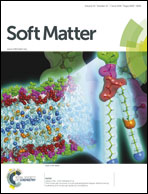Nonvolatile memory effects in an orthoconic smectic liquid crystal mixture doped with polymer-capped gold nanoparticles
Abstract
Promising applications of liquid crystal nanocomposites have driven extensive efforts to achieve non-volatile memory effects for the realization of electronic storage devices. In this context, non-volatile memory effects in an orthoconic smectic liquid crystal mixture, with and without polymer capped gold nanoparticles, were investigated. The dielectric spectroscopy technique was performed by applying a d.c. bias during the measurement or a d.c. potential before the start of the measurement in order to obtain pre-conditioning of the sample. Both techniques showed the presence of non-volatile memory effects in the pure orthoconic smectic liquid crystal mixture similar to the doped one. The results demonstrate that the addition of gold nanoparticles enhances the memory effect making it permanent. Our experimental evidence underlines the importance of the structure of the host liquid crystal and clearly suggests that the prolonged time memory effect, observed in the doped liquid crystal, is due to the electric field inducing charge transfer from the liquid crystal molecules to the gold nanoparticles, thanks to the polymer-capping which acts as an ionic charge trapper. Such an ionic trap effect is also responsible for strong reduction of total conductivity of the doped system.


 Please wait while we load your content...
Please wait while we load your content...